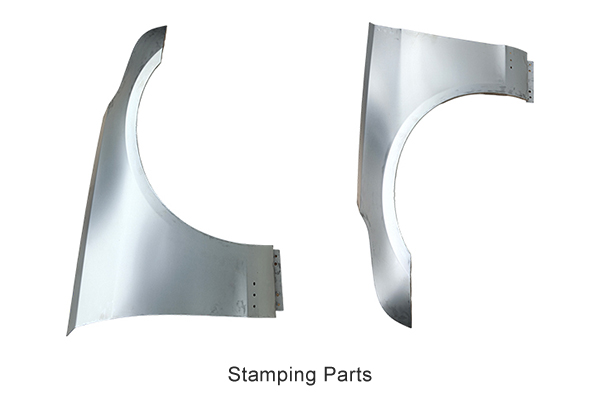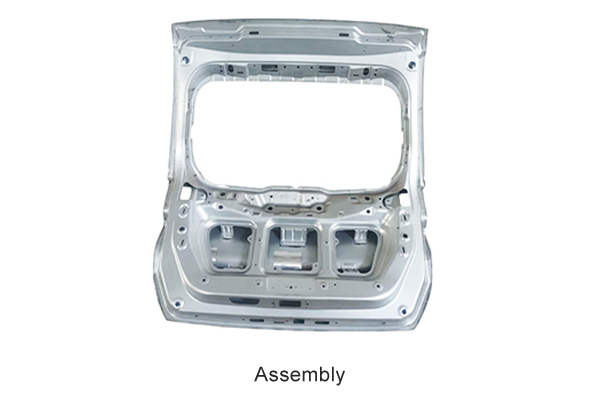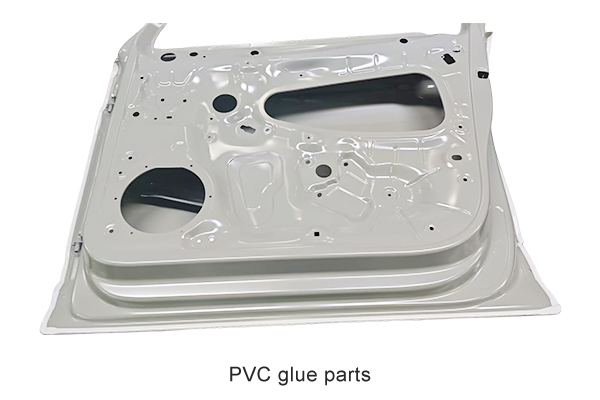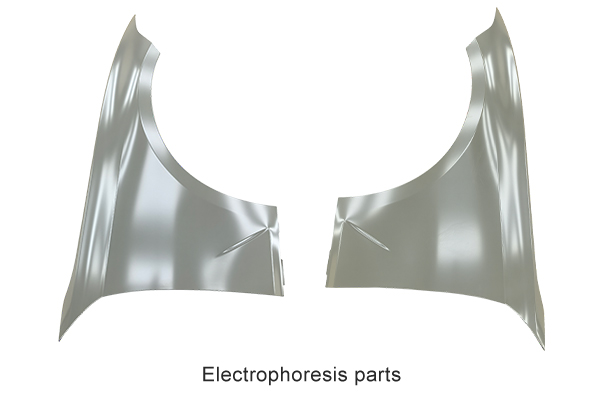How to improve the weather resistance of automotive parts by improving PVC coating services?
Release Time : 2025-07-03
In modern automobile manufacturing, PVC (polyvinyl chloride) coating is an important surface treatment technology, which is widely used in the protection and decoration of metal parts such as doors, chassis, and wheel covers. Its main function is not only sealing and rust prevention, but also undertakes the important task of improving the aesthetics of the whole vehicle and extending its service life. However, in the face of complex and changing climate environments and increasingly stringent quality requirements, traditional PVC coating services have been difficult to meet higher weather resistance requirements.
1. Optimize the PVC material formula to enhance anti-aging ability
The weather resistance of PVC coatings depends first on its basic formula. Although traditional PVC coatings have good sealing and adhesion, they are prone to oxidation, powdering and even cracking when exposed to ultraviolet rays, high temperature, humidity and other environments for a long time. In order to solve this problem, many manufacturers have begun to add additives such as antioxidants, ultraviolet absorbers and heat stabilizers to the formula in recent years. These ingredients can effectively delay the breaking process of PVC molecular chains, thereby significantly improving the stability of the coating in extreme weather. In addition, the use of nano-scale fillers can further enhance the density and mechanical strength of the coating, making it more resistant to weathering and erosion.
2. Introducing advanced curing technology to improve the cross-linking density of the coating
The curing process after PVC coating has a decisive influence on the final coating performance. Traditional drying methods often have problems such as uneven temperature and inaccurate time control, resulting in insufficient cross-linking inside the coating, affecting its weather resistance. At present, the industry is gradually promoting infrared heating + convection composite curing process. This new curing method can achieve uniform temperature rise in a short time, so that the PVC coating can achieve higher cross-linking density and structural stability. At the same time, some high-end models have also begun to try to use UV-assisted curing technology to accelerate the polymerization reaction through ultraviolet irradiation, thereby shortening the curing cycle and improving the durability of the coating.
3. Improve the spraying process to ensure uniform coverage of the coating
Spraying is the most critical part of the PVC coating process, and its quality directly affects the thickness, uniformity and adhesion of the coating. In order to improve the weather resistance of automotive parts, it is necessary to ensure that the entire coating surface is evenly and continuously covered. At present, more and more companies are using robot automatic spraying systems to replace traditional manual operations. Through high-precision positioning and constant pressure feeding technology, defects such as leaking spray and dripping are greatly reduced. In addition, the combination of electrostatic spraying technology can effectively improve the utilization rate of the coating, making the coating denser and smoother, thereby enhancing its ability to resist external environmental erosion.
4. Strengthen the pre-treatment process to improve adhesion
Whether the PVC coating can be firmly attached to the metal substrate is one of the key factors that determine its weather resistance. To this end, it is necessary to pay attention to the pre-treatment process, including degreasing, phosphating, passivation and other links. Through efficient cleaning and surface activation treatment, impurities and oxide layers on the metal surface can be removed to form a stable chemical conversion film, thereby significantly improving the bonding between the PVC coating and the substrate. Some advanced factories have also introduced silane coupling agent treatment technology to further enhance the adhesion effect and anti-peeling ability of the coating, so that the coating remains stable in an environment with frequent temperature changes.
5. Strengthen the post-treatment process to improve surface protection performance
After completing the PVC coating, appropriate post-treatment processes should not be ignored. For example, grinding and polishing can remove minor flaws on the coating surface and improve the overall flatness; while using varnish or functional coating to cover can form an additional protective barrier on the PVC surface, effectively blocking the invasion of ultraviolet rays, rain and acid rain. Some high-performance products will also add hydrophobic or self-cleaning functions to the coating surface, which not only improves the aesthetics but also reduces the cost of daily maintenance.
6. Establish a complete quality inspection system to ensure process stability
In order to ensure that the improved PVC coating services really play a role, a scientific quality inspection system needs to be established. This includes comprehensive testing of key indicators such as coating thickness, hardness, adhesion, salt spray resistance, and UV aging performance. Through regular sampling and data analysis, process fluctuations can be discovered and adjusted in time to ensure that the weather resistance of each batch of products meets the design standards. In addition, with the help of AI visual recognition and big data analysis technology, online real-time monitoring can be achieved to further improve the controllability and consistency of coating quality.
In summary, by optimizing material formulation, improving curing and spraying processes, strengthening pre-treatment and post-treatment processes, and establishing a sound quality inspection mechanism, the weather resistance of PVC coatings on automotive parts can be significantly improved. This not only helps to extend the service life of the vehicle, but also improves the appearance quality and market competitiveness of the vehicle.
1. Optimize the PVC material formula to enhance anti-aging ability
The weather resistance of PVC coatings depends first on its basic formula. Although traditional PVC coatings have good sealing and adhesion, they are prone to oxidation, powdering and even cracking when exposed to ultraviolet rays, high temperature, humidity and other environments for a long time. In order to solve this problem, many manufacturers have begun to add additives such as antioxidants, ultraviolet absorbers and heat stabilizers to the formula in recent years. These ingredients can effectively delay the breaking process of PVC molecular chains, thereby significantly improving the stability of the coating in extreme weather. In addition, the use of nano-scale fillers can further enhance the density and mechanical strength of the coating, making it more resistant to weathering and erosion.
2. Introducing advanced curing technology to improve the cross-linking density of the coating
The curing process after PVC coating has a decisive influence on the final coating performance. Traditional drying methods often have problems such as uneven temperature and inaccurate time control, resulting in insufficient cross-linking inside the coating, affecting its weather resistance. At present, the industry is gradually promoting infrared heating + convection composite curing process. This new curing method can achieve uniform temperature rise in a short time, so that the PVC coating can achieve higher cross-linking density and structural stability. At the same time, some high-end models have also begun to try to use UV-assisted curing technology to accelerate the polymerization reaction through ultraviolet irradiation, thereby shortening the curing cycle and improving the durability of the coating.
3. Improve the spraying process to ensure uniform coverage of the coating
Spraying is the most critical part of the PVC coating process, and its quality directly affects the thickness, uniformity and adhesion of the coating. In order to improve the weather resistance of automotive parts, it is necessary to ensure that the entire coating surface is evenly and continuously covered. At present, more and more companies are using robot automatic spraying systems to replace traditional manual operations. Through high-precision positioning and constant pressure feeding technology, defects such as leaking spray and dripping are greatly reduced. In addition, the combination of electrostatic spraying technology can effectively improve the utilization rate of the coating, making the coating denser and smoother, thereby enhancing its ability to resist external environmental erosion.
4. Strengthen the pre-treatment process to improve adhesion
Whether the PVC coating can be firmly attached to the metal substrate is one of the key factors that determine its weather resistance. To this end, it is necessary to pay attention to the pre-treatment process, including degreasing, phosphating, passivation and other links. Through efficient cleaning and surface activation treatment, impurities and oxide layers on the metal surface can be removed to form a stable chemical conversion film, thereby significantly improving the bonding between the PVC coating and the substrate. Some advanced factories have also introduced silane coupling agent treatment technology to further enhance the adhesion effect and anti-peeling ability of the coating, so that the coating remains stable in an environment with frequent temperature changes.
5. Strengthen the post-treatment process to improve surface protection performance
After completing the PVC coating, appropriate post-treatment processes should not be ignored. For example, grinding and polishing can remove minor flaws on the coating surface and improve the overall flatness; while using varnish or functional coating to cover can form an additional protective barrier on the PVC surface, effectively blocking the invasion of ultraviolet rays, rain and acid rain. Some high-performance products will also add hydrophobic or self-cleaning functions to the coating surface, which not only improves the aesthetics but also reduces the cost of daily maintenance.
6. Establish a complete quality inspection system to ensure process stability
In order to ensure that the improved PVC coating services really play a role, a scientific quality inspection system needs to be established. This includes comprehensive testing of key indicators such as coating thickness, hardness, adhesion, salt spray resistance, and UV aging performance. Through regular sampling and data analysis, process fluctuations can be discovered and adjusted in time to ensure that the weather resistance of each batch of products meets the design standards. In addition, with the help of AI visual recognition and big data analysis technology, online real-time monitoring can be achieved to further improve the controllability and consistency of coating quality.
In summary, by optimizing material formulation, improving curing and spraying processes, strengthening pre-treatment and post-treatment processes, and establishing a sound quality inspection mechanism, the weather resistance of PVC coatings on automotive parts can be significantly improved. This not only helps to extend the service life of the vehicle, but also improves the appearance quality and market competitiveness of the vehicle.








